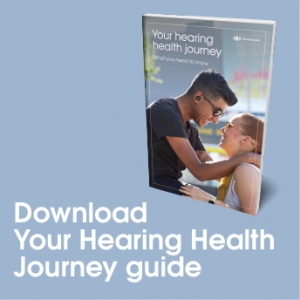
by Chris Griffith, View original article at The Australian »
June 12, 2018
IQbuds Boost adjusts the volume of various frequencies to compensate for hearing loss.
If you’ve listened to too much high volume Black Sabbath, Deep Purple or AC/DC during your lifetime, the science of augmented hearing might come to your rescue.
Indeed, we baby boomers are likely paying for the excessively loud music we’ve endured during our extended youths. We are still young at heart, but with battered ear drums and it’s self-inflicted.
Our delicate ears are not built to withstand the humungous decibels blasted out at many live concerts. When researching this review, I came across the Cavan Project, which surveyed the loudest bands. Guinness used to, but dropped the practice, fearing it was promoting hearing loss.
Keep in mind that sounds above about 85 decibels can cause hearing loss, and at about 120 decibels you enter the pain threshold.
According to Cavan, Swedish rockers Sleazy Joe holds the record with 143.2dB in 2008, followed by Manowar with 139dB the same year. Apparently, Leftfield’s 137dB in 1996 caused the plaster to fall from the roof of the Brixton Academy in London.
By now you get my drift; we baby boomers have punished our ears and may face a quieter future as we head towards dotage time — without scientific help.
That’s where “hearables” come in. They are a growing market where Australia is doing particularly well. Melbourne-based Nura and Brisbane start-up Audeara are making headphones that compensate for lost hearing.
Perth’s Nuheara, however, has packaged all this clever tech into a pair of small wireless earbuds that fits snugly into your ears, called IQBuds Boost. You get nine sets of various sized earbud cushion covers, both oval and circular, so there’s a great chance you’ll get a tight fit.
[/av_textblock]
Each earbud weighs eight grams and the pocket-sized case doubles as a charger. Nuheara claims five hours audio streaming and eight hours of hearing processing per charge, and three earbud recharges from the case before you recharge the case itself.
After fitting the covers, I downloaded and fired up the IQBuds app to personalise the earbuds. They connect to a smartphone through Bluetooth.
The main personalisation task involves a 15-minute “Ear ID” hearing test where I listened for a series of faint tones. I’d tap the screen each time I heard one. When I heard nothing for a while, I assumed my hearing was lacking at that frequency.
My profile reflected what I know about my hearing; that my left ear hearing is fine but the right doesn’t register some high frequencies.
From then onwards, the IQBuds Boost adjusts the volume of various frequencies to compensate for that lack of hearing.
The result is a more balanced sound and I enjoyed hearing instruments and higher pitched sound in that right ear that I thought never existed on tracks I’ve been listening to for years.
Of course, if your hearing is badly impaired, even hearables may be of limited help and you’ll need a professionally fitted hearing aid.
Nuheara says more than three million folk in Australia suffer some hearing impairment and it is targeting the 70 per cent of people suffering mild to moderate hearing loss.
My only complaint is that I’d like an in-built equaliser so that I could turn up the bass for more boom (my weakness) but that would probably undermine the rationale of frequency adjustment from the test.
The IQBuds Boost has other strings to its bow. The app lets you adjust the volume of ambient noise let in from the surroundings and you can use this whether you are listening to music or not. Nuheara terms it “world volume”.

Dial -10 and minimal noise gets through; 0 is neutral and +10 amplifies ambient noise.
I found world volume impacted differently at different frequencies. If I clap my hands, I can barely hear it at -10 but I hear it loudly at +10-. It’s very effective. The same applies to the clackety-clack of the noisy keyboard I use.
I live not terribly far from Mascot Airport at Sydney, and while I hear some of the rumble of planes overhead, I no longer hear the whine of the engines.
There are seven variations of world noise. “Street” reduces the frequencies associated with street and city sounds; “home” seeks to also boost conversations; “restaurant” amplifies speech and reduces background noise; and “driving” seeks to block driving and tyre noise. There’s “office”, “plane” and “workout” modes also. This can be set from the IQBuds app.
Don’t expect these to work perfectly, but it’s entirely possible to minimise and maximise groups of frequencies associated with types of sound. It’s therefore viable to get value from IQBuds Boost even if you’re not listening to tracks.
Finally, there’s the “tap touch” feature, which lets you configure a single tap, double tap and long tap you can make on either earbud.
You can assign “play/pause”, “Google Assistant”, World On/Off”, “change locations” volume up and down and next and previous track to tap sequences.
The tapping areas on the buds are big enough targets to make this practically useful.
The Android app had a glitch where, after some use, one screen of the app overwrote another.
I couldn’t read text. This was resolved by restarting it.
At a recommended $649, the IQBuds Boost is cheaper than a decent hearing aid but expensive for wireless earbuds. Apple AirPods are $229 and the BeoPlay E8 costs $449. But it might be worth the money to hear the detail of tracks you’ve missed for years. Just avoid those big decibels!
IQbuds Boost are available online at nuheara.com and from retailers focused on hearing health.
Nuheara IQbuds Boost
Price $649 AUD / $499 USD / £279 GBP
Rating: 8/10
This article was originally published by the Australian Business Review


